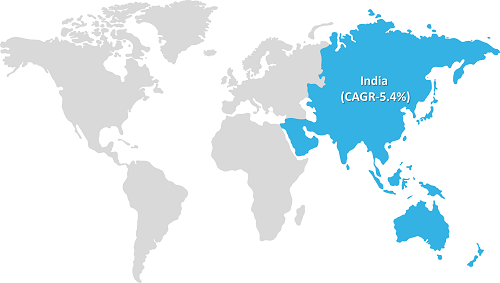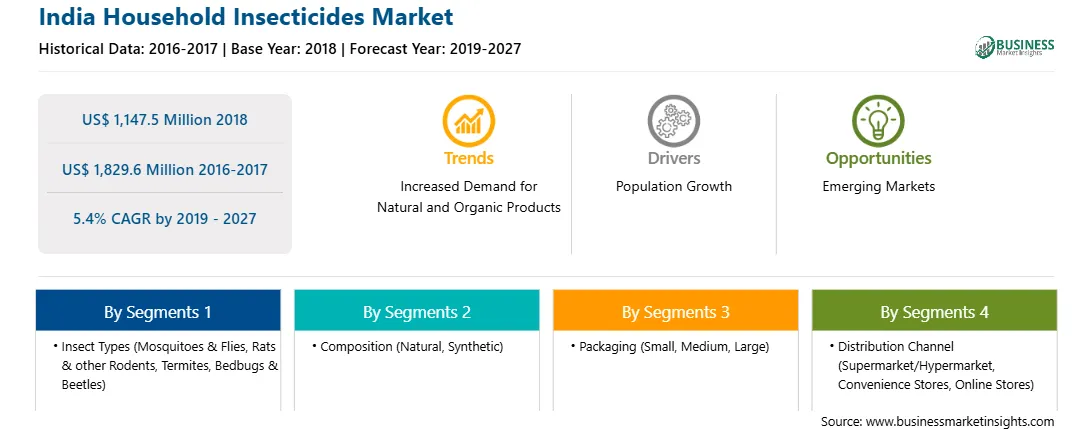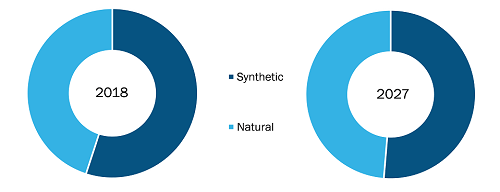The India household insecticides market is accounted to US$
1,147.5 Mn in 2018 and is expected to grow at a CAGR of 5.4% during the forecast period 2019 - 2027, to account to US$ 1,829.6 Mn by 2027.
Household insecticides are the chemical used to destroy insects from the houses. Insecticides also include the chemicals or substances applied to the surfaces of clothes or houses to control the growth of insects or roaches and to the skin to repel the contact of insects. Household insecticides products are available in different forms, such as gels/creams, aerosols, vaporizers, mats, granules, patches, powdered, and roll-on. The growing emphasis on the control of insect vectors by local and national government bodies has bolstered the growth of the India household insecticides market.

Strategic insights for the India Household Insecticides provides data-driven analysis of the industry landscape, including current trends, key players, and regional nuances. These insights offer actionable recommendations, enabling readers to differentiate themselves from competitors by identifying untapped segments or developing unique value propositions. Leveraging data analytics, these insights help industry players anticipate the market shifts, whether investors, manufacturers, or other stakeholders. A future-oriented perspective is essential, helping stakeholders anticipate market shifts and position themselves for long-term success in this dynamic region. Ultimately, effective strategic insights empower readers to make informed decisions that drive profitability and achieve their business objectives within the market.

| Report Attribute | Details |
|---|---|
| Market size in 2018 | US$ 1,147.5 Million |
| Market Size by 2027 | US$ 1,829.6 Million |
| Global CAGR (2019 - 2027) | 5.4% |
| Historical Data | 2016-2017 |
| Forecast period | 2019-2027 |
| Segments Covered |
By Insect Types
|
| Regions and Countries Covered | India
|
| Market leaders and key company profiles |
The geographic scope of the India Household Insecticides refers to the specific areas in which a business operates and competes. Understanding local distinctions, such as diverse consumer preferences (e.g., demand for specific plug types or battery backup durations), varying economic conditions, and regulatory environments, is crucial for tailoring strategies to specific markets. Businesses can expand their reach by identifying underserved areas or adapting their offerings to meet local demands. A clear market focus allows for more effective resource allocation, targeted marketing campaigns, and better positioning against local competitors, ultimately driving growth in those targeted areas.

Market Insights
Rising demands from rural markets to boost the household insecticides market
The rising incidences and growing awareness about diseases caused by mosquitoes, flies, cockroaches, rats, and others have created a need for mosquito repellants and insect care products. These products are available in various forms, including lotions, sprays, coils, repellant paints, and repellant pills, and at a lower price, and thus consumers in rural India can afford them. The increasing prevalence of mosquito-borne diseases will bolster the demand for mosquito repellants, consequently fueling the growth of the household insecticide market in the rural region during the forecast period.
New product development provides an opportunity for the household insecticides market growth
Product innovation is the most common market strategy adopted by firms to increase market penetration in rural areas and consumption growth in urban areas. Currently, spray/aerosol insecticides recorded the fastest growth, followed by electric insecticides. Moreover, the use of insecticide coils, which costs less per unit and available in wider options are preferred by low-income Indians. However, Indian companies such as Jyothy Laboratories and Godrej Consumer Products Limited have introduced a range of low priced products such as mosquito repellent cards priced at INR 1 per card mainly to tap the rural consumers. In addition, new players are also investing heavily in R&D activities to develop new and innovative products in order to sustain the competition in the India household insecticides market.
Insect Types Insights
The India household insecticides market by insect types has been categorized in mosquitoes & flies, rats & other rodents, termites, bedbugs & beetles, others. In 2018, the mosquitoes & flies segment accounted for a larger share of the India household insecticides market. Mosquitos and flies are one of the major insects which are perceived to cause diseases. An increase in unhygienic environmental conditions and rapid urbanization are leading to the multiplication of mosquito and flies population. Anopheles and Aedes aegypti species of mosquito-spread several types of diseases such as Malaria, Dengue, Zika, and Chikungunya. Malaria has been a major problem in India for centuries. The rise in populations of insects, along with the growing awareness about insect-borne diseases, is expected to drive the growth of the India household insecticides market.
Composition Insights
On the basis of composition, the India household insecticides market has been segmented into natural and synthetic. Under the composition segment, synthetic household insecticides are the leading segment in the India household insecticides market. Moreover, the natural household insecticides segment is projected to register for a higher CAGR over the forecast period. Chemicals used in synthetic household insecticides are hazardous for human health. They cause headaches, dizziness, muscular weakness, nausea, and several other health issues. The government of India has also imposed stringent regulations on chemicals that to be used in these products. The rising consumer awareness about the side effects of synthetic household insecticides, coupled with government regulations, has boosted the demand for household insecticides made by natural and organic ingredients. These factors are projected to boost the natural household insecticides market in India.

Strategic insights for the India Household Insecticides provides data-driven analysis of the industry landscape, including current trends, key players, and regional nuances. These insights offer actionable recommendations, enabling readers to differentiate themselves from competitors by identifying untapped segments or developing unique value propositions. Leveraging data analytics, these insights help industry players anticipate the market shifts, whether investors, manufacturers, or other stakeholders. A future-oriented perspective is essential, helping stakeholders anticipate market shifts and position themselves for long-term success in this dynamic region. Ultimately, effective strategic insights empower readers to make informed decisions that drive profitability and achieve their business objectives within the market.

| Report Attribute | Details |
|---|---|
| Market size in 2018 | US$ 1,147.5 Million |
| Market Size by 2027 | US$ 1,829.6 Million |
| Global CAGR (2019 - 2027) | 5.4% |
| Historical Data | 2016-2017 |
| Forecast period | 2019-2027 |
| Segments Covered |
By Insect Types
|
| Regions and Countries Covered | India
|
| Market leaders and key company profiles |
The geographic scope of the India Household Insecticides refers to the specific areas in which a business operates and competes. Understanding local distinctions, such as diverse consumer preferences (e.g., demand for specific plug types or battery backup durations), varying economic conditions, and regulatory environments, is crucial for tailoring strategies to specific markets. Businesses can expand their reach by identifying underserved areas or adapting their offerings to meet local demands. A clear market focus allows for more effective resource allocation, targeted marketing campaigns, and better positioning against local competitors, ultimately driving growth in those targeted areas.

Strategic Insights
New product development and strategy and business planning strategies were observed as the most adopted strategies in the India household insecticides market. Few of the recent developments in the India household insecticides market are listed below:
2019:
Godrej Consumer Products has signed tripartite MOU with the Government of Uttar Pradesh to further its commitment to eliminate malaria in India by 2030.
2019:
Godrej Consumer Products unveiled emojis campaign on world malaria day to create awareness of malaria symptoms amongst people
2018:
Godrej Consumer Products launches 'Goodknight Naturals Neem Agarbatti.
The List of Companies
The India Household Insecticides Market is valued at US$ 1,147.5 Million in 2018, it is projected to reach US$ 1,829.6 Million by 2027.
As per our report India Household Insecticides Market, the market size is valued at US$ 1,147.5 Million in 2018, projecting it to reach US$ 1,829.6 Million by 2027. This translates to a CAGR of approximately 5.4% during the forecast period.
The India Household Insecticides Market report typically cover these key segments-
The historic period, base year, and forecast period can vary slightly depending on the specific market research report. However, for the India Household Insecticides Market report:
The India Household Insecticides Market is populated by several key players, each contributing to its growth and innovation. Some of the major players include:
The India Household Insecticides Market report is valuable for diverse stakeholders, including:
Essentially, anyone involved in or considering involvement in the India Household Insecticides Market value chain can benefit from the information contained in a comprehensive market report.